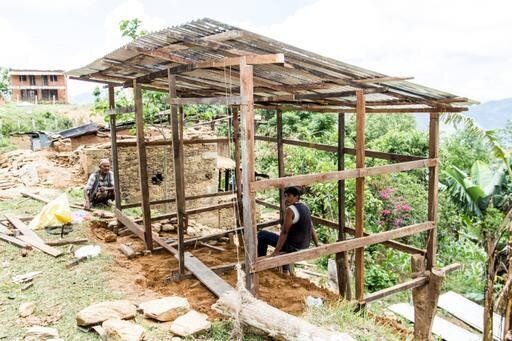
Credit: Christian Aid/Sam Spickett
The earthquakes that shook Nepal on 25th April and 12th May, killing nearly 9,000 people - many are still deemed missing - and injuring thousands, have together been described as the biggest disaster in the history of this small mountainous nation. Regular tremors and aftershocks continue to unsettle the lives and minds of the people who continue to try to resume normality six months on. Now the looming winter will bring freezing temperatures and snow, presenting further challenges to their health and well-being.
Travelling through affected areas shortly after the first earthquake, the scene looked like a war zone. People had lost loved ones, their homes built with life savings flattened to the ground, livestock killed and their means to make a living destroyed. The grief and trauma experienced by the people I met was acute, particularly in parents whose children were killed.
When I reached Gumsakot, a village in Sindhupalchowk district in the eastern part of the country, villagers waited eagerly for food packages from a Nepalese Army helicopter hovering above. Shubha Lama, a father who lost all three of his children when a wall fell on them while they were playing outside, was lying in a temporary shelter, erected by fellow villagers, with a broken leg. His sense of loss and helplessness was very painful to witness. His village lost 45 people in total, mostly women and young children, and was exacerbated by the ongoing fear of the next big earthquake. Aftershocks had become a permanent and constant threat in the region.
As I moved between districts, the scale of the catastrophe became increasingly clear. Sindhupalchowk was one of the worst-affected districts and has suffered most in terms of lost lives and destroyed property. We prioritised our response and distributed food and supplies across the most hard to reach locations in the district. Within the first month, we were able to reach more than 3,000 households (around 15,000 Individuals) with food, hygiene kits (including water purification tablets) and shelter kits across five districts. To date, we have reached more than 100,000 affected people.
Visiting the epicenter district, Dolakha on the morning after the second earthquake, we came across deserted villages that felt like ghost towns. Almost all the buildings were either destroyed or badly damaged, making them uninhabitable. Two colleagues and I had to evacuate the hotel we were staying in as it was deemed unsafe. We had no choice but to sleep in our car for three nights before we could find alternative accommodation in a tent.
A few weeks later came the start of the monsoon season and hundreds of mud roads leading to the remote villages became inaccessible. During the peak of the rains, more that 50 percent of Sindhupalchowk was not reachable. Agencies' response was severely challenged by the lack of suitable and safe roads required to get to remote locations.
Our local partner organisations constantly faced such challenges which often involved getting stuck for days in isolated villages with limited supplies, walking for hours to reach the nearest road and delivering aid in constant fear of aftershocks and landslides.
Now the next challenge is winter. Temperatures regularly reach below freezing in Nepal, even more so in the mountains. Christian Aid and other aid agencies are working against the clock to make sure people are prepared and have appropriate shelter and warmth before mid- December.
Although we are delivering blankets and cooking stoves, our main focus has been improving the temporary shelters that were put in place in the days following the earthquakes. Through our partners we are training carpenters and masons to make earthquake-resilient and well-insulated shelters that use locally sourced materials. This significantly enhances the longevity of the shelters and means people can fend against the cold weather as they prepare to build permanent shelters in the future.
Harvesting will also become challenging over the colder months, so together with our partners we are helping people to build up their food stocks before the temperatures dip by providing a variety of vegetable seeds, bio fertilizers, tools and training. At the same time, this is helping communities to re-establish ways to earn a living.
These efforts have been slowed dramatically by an ongoing fuel shortage - due to border issues between Nepal and India - which is making the entire response action very problematic. Despite best attempts to pool and conserve resources, aid agencies are struggling to deliver as much assistance and as quickly as they would want.
This has also led to a serious lack of much-needed items in the local markets, making the timely procurement of blankets, stoves, seeds, tools and shelter materials very difficult, which will have a long-term impact on the overall recovery process.
Agencies need to focus on the ongoing recovery work as well as delivering assistance in the testing conditions ahead of winter. There are huge challenges not only for the people of Nepal - who are making every effort to bounce back - but also for the humanitarian organisations who are striving to deliver against strict timelines and enormous physical and climatic difficulties.